

Step Inside the Cargill Salt Mines Under Lake Erie
On Whiskey Island, a large, cage-like hoist travels 1,800 feet beneath Lake Erie at a four-minute pace — a rapid trip that feels like a hellish eternity to an outsider. For Cargill employees, the descent, which can reach a top speed of 500 feet per minute, is more akin to the mundane morning elevator ride, en route to one of Cleveland’s most unique workplaces: the underground mine, a cavernous world unto itself where the salt used to clear winter’s icy roads is harvested each day.
Encompassing a total of 16 square miles beneath the lake, the mine’s primary tunnel extends four miles north of the lakefront. From this central line, a growing number of tunnels running east and west are mined through a tried-and-true process used since the site’s earliest excavation, after the salt deposit was first accessed in the late 1950s and extraction began in 1962.
“It’s surprisingly similar to how it was mined 50 years ago, as far as the cycle goes,” says David Harris, an engineer in the Cleveland mine. “We have adopted some underground wireless things, but most of the technology above ground doesn’t work underground, because we can’t see satellites.”
RELATED: Why Does Lake Erie Have So Many Shipwrecks?
To begin the mining cycle, the salt deposit’s face is drilled with holes, which are “powdered,” or filled with explosives. These explosives are detonated through the process of “shooting,” which leaves a cleared space filled with salt and rock, just over 20 feet deep.
A bulldozer-like loader “mucks,” or clears, the area, and the deposit’s fresh faces are scraped for loose salt rocks. The ceiling of the cleared tunnel is filled with six-foot bolts, long enough to reach the layer of rock above the salt to secure the structural integrity of the newest stretch of the tunnel.
Twelve miles of conveyor belts and sorting machinery carry salt and rock from the heart of the mine, and usable salt is transported above ground through a production hoist, to be loaded on a shipping vessel or stored for later use. April begins Cargill’s boat-shipping season, which runs through the end of the year, during which two to three vessels, such as the “Mark Barker,” a 639-foot ship produced by the Interlake Steamship Co., carries 18,000 to 20,000 tons of salt per shipment.
Bob Nelson, an engineering manager who earned a bachelor's degree in mining engineering at Virginia Tech University and has worked in different Cargill locations for the last 15 years, says working in salt is pretty stable, at least when compared to other areas of the niche industry, such as metals and coal, where the demands fluctuate with the markets.
Given the inherent danger an icy winter poses to drivers in Cleveland and abroad, it’s no surprise that this local operation runs around the clock each day, as 223 employees coordinate to fulfill a daily average target of 12,000 tons of salt.
What is surprising? During my return from a tour of the mine, the chilly spring winds off the coast of Lake Erie nearly had me rushing back underground, where the temperature constantly hovers around 70 degrees.
Part of this environmental control is due to sets of sealed doors, which close off the primary corridor from the mine shaft to separate the incoming fresh air, transported via the pull of the descending hoist, from outgoing fumes and exhaust. Anyone spending substantial time in the mine will carry a heavy gasoline scent upon exit, but breathing in the mine isn’t difficult or nauseating, thanks to its ventilation system.
Fresh air carries through the mine’s spine: the dark, central corridor from which each new extraction begins. After mining is complete, these spaces are back-filled with rock, unusable salt, and even retired equipment, before being covered by berms and curtains that better direct fresh air to the mine’s furthest depths.
RELATED: 9 Unique Underwater Creatures That Call Lake Erie Home
On the side of the path, mechanics and engineers can be found oiling up the heavy-duty machinery that remains operational due to the mine’s lack of humidity. Were the equipment to once again see the light of day, it would likely rust out of usability within a month. A central hub within the mine includes shops and vending machines, where Cargill employees can find spare parts and equipment for repairing all of the tools used below ground.
The headlights of vehicles akin to oversized golf carts, two rows deep, cut through the darkness of the mine, carrying Cargill’s workers the miles between entry and wherever they are stationed for the day’s shift.
While away from the stalks of floodlight found occasionally throughout the mine, my tour guide, Greg Jacknewitz, an eight-year employee of Cargill who has been the Cleveland mine’s manager for close to a year, cuts our cart’s headlights to introduce me to the special kind of darkness that exists within the mine — the kind where you can’t see your hand just a couple of inches away from your face.
For this reason, headlamps are an imperative for miners and visitors alike. Any person entering the mine begins the trip by taking one of many numbered, battery-powered headlamps, which can be tracked throughout the mine. A metal dog tag, with the headlamp’s number, is registered above ground and carried beneath, as an added measure of precaution.
The intricate, danger-filled mining operation requires a great deal of safety measures and clear communication among the miners. Color-coded reflectors line the central tunnel, guiding miners to exit paths in the event of a necessary evacuation. Over 100 FEMCO phones, used like walkie-talkies, are found in strategic locations. Each features a detailed map that shows where to find emergency breathing equipment and the mine’s safe rooms, which can sustain inhabitants for three days in a perilous situation.
For Nelson, it was the company’s “safety culture” that initially attracted him to Cargill when first entering the niche industry out of college.
“The most important thing to come out of the mine is the miner, so it’s one of the things that drew me to Cargill and has kept me here.”
8:00 AM EST
July 31, 2023
Related Articles
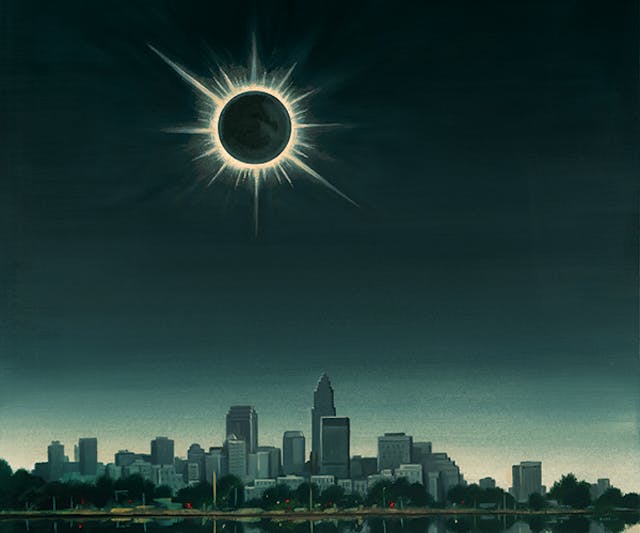
Once-In-a-Lifetime: Total Solar Eclipse Puts a Spotlight on Cleveland
Northeast Ohio organizers and residents are preparing for the celestial event of the century, and the hundreds of thousands of visitors that will come with it. By Annie Nickoloff

Cleveland Magazine's Most Interesting People 2024
When you learn about a person's life, there's often more to the story - and that's certainly the case with this year's class of Most Interesting People. You'll meet a kid who breaks athletic records; a grandmother who established internet stardom; an artist who opened a bar; a doctor who moonlights as a magician. One thing they all have in common? Creativity and grit. Edited by Annie Nickoloff
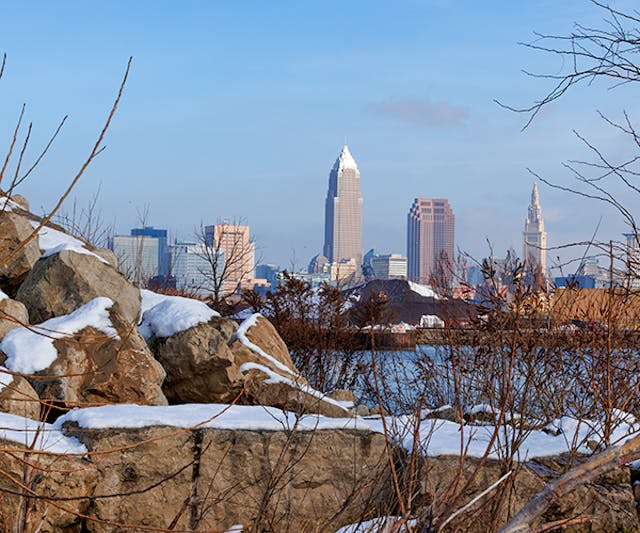
2023 CLE Wrapped: Cleveland's Year in Review
We look back on the stories, the music, the books, the sports events and more that defined 2022. By Cleveland Magazine Staff
- Sports Page
- Cayuga County
- Livingston County
- Ontario County
- Schuyler County
- Seneca County
- Steuben County
- Tompkins County
- Wayne County
- Yates County
- Now Streaming

After deadly accident Cargill will shut down salt mine, but company claims its not because of recent collapse
- June 4, 2023 5:37 AM
Six weeks after a roof collapse killed two miners at its Avery, La., rock salt mine, Cargill has announced plans to permanently close the facility.
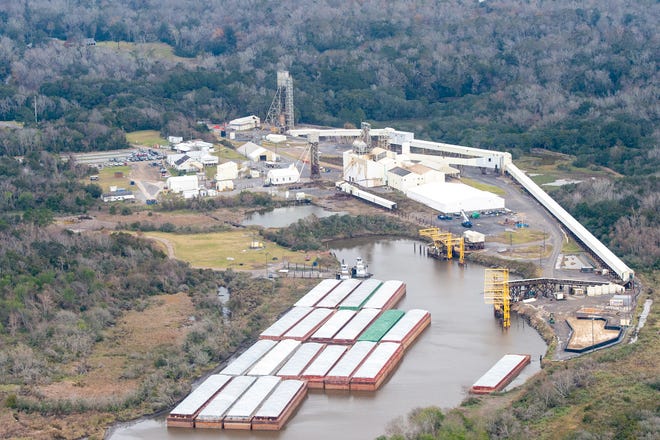
One of three Cargill mines in the U.S. that produce rock salt used to deice winter roads, Avery produces about 2 million tons of salt a year — roughly the same amount as its Lansing mine beneath Cayuga Lake.
The other Cargill salt mine under Lake Erie near Cleveland produces about 3 million tons a year.
The Avery mine employs about 200 people. Cargill said it has operated it for 24 years.
The company said Thursday that it had already planned to halt production at Avery later this year when its lease with the landowner, Avery Island Inc., ends.
However, federal law requires companies to notify the state within 60 days of closing a worksite of 50 or more, and Cargill had not filed such a notice as of Jan. 19, the Acadiana Advocate reported, citing Louisiana state records.
The fatal accident at the mine Dec. 14 may have been a key factor in the closure, according to Cayuga Lake Environmental Action Now (CLEAN).

CLEAN has warned that Cargill’s Cayuga Lake mine is vulnerable to a roof collapse as the company mines under sections of thinning bedrock separating the mine from the lake.
“It’s possible that blaming the closure (of Avery) on the McIlheny family’s unwillingness to renew the lease distracts from revealing that mine safety and water leakage into the mine were more significant issues,” CLEAN’s Stephanie Redmond said Saturday.
A group of 18 employees were working in the Avery mine on Dec. 14 when a portion of the roof collapsed. Sixteen miners escaped, but two were counted as missing for two days before their bodies were found.
A preliminary report from the federal Mining Safety and Health Administration found that the two who died were trying to stop a water leak when one of the mine’s chambers collapsed near a rock fault, according to the Lafayette Daily Advertiser.

“Two miners died when a back failure occurred in a large intersection,” the MSHA report reads, according to the Advertiser. “The miners were drilling in an attempt to intercept water leaks when blocks of salt and anhydrite fell from beneath a slickenside onto the miners.”
Normal operations at the mine had not resumed as of Jan. 22, while investigations continued, Cargill’s Daniel Sullivan told WaterFront on that date.
Six days later the company announced the permanent shutdown. Cargill said the process of closing the mine will likely take until 2024. “The company is working with employees to offer a variety of support services as they are needed,” the company said in a statement Jan. 28 .
Cargill’s Cayuga mine also employs about 200. The company has permits to mine 13,000 state-owned acres of leased mining reserves under the lake. The mine is roughly 2,200 below ground level.
The company is completing a controversial new ventilation and egress shaft that will facilitate mining toward the northern end of the reserves.
For several years, CLEAN, independent scientists, the Town of Ithaca and other neighboring municipalities have raised concerns about a potential catastrophic roof collapse at Cargill Cayuga. Even so, the past five New York State governors have not required the company to provide an environmental impact statement for its sub-lake mining.
In a pending legal appeal, CLEAN and others are seeking to compel the company and the Cuomo Administration’s Department of Environmental Conservation to provide an EIS.
The state has required Cargill’s chief in-state competitor, American Rock Salt in Livingston County, to produce an EIS.
“American Rock Salt’s Hampton Corners Mine … is newer, safer and more productive than Cargill’s Lansing mine,” Redmond said. “We hope Cargill and the DEC are coming to the conclusion that mining under Cayuga Lake is too risky for both Cargill’s miners and for the potability of Cayuga Lake water and the surrounding aquifer.”
In 2013, miners at Cargill’s Erie salt mine were evacuated due to mine safety concerns. The mine was closed for 10 days in that incident.
Get the latest headlines delivered to your inbox each morning. Sign up for our Morning Edition to start your day . FL1 on the Go! Download the free FingerLakes1.com App for Android (All Android Devices) or iOS (iPhone, iPad) .

Peter is a three-time Pulitzer nominated reporter covering environmental issues through his first-of-its-kind digital publication The Water Front . He’s won an array of Associated Press, UPI, and Society of Professional Journalist awards. His reporting on environmental issues continues to be featured in prominent New York publications and is available on FingerLakes1.com through an exclusive content partnership. Have a question or lead? Send it to [email protected] .

welcome to strataca THE underground salt museum
Welcome to strataca the underground salt museum, what is strataca, it's the perfect family adventure.
At Strataca we are passionate about providing all of our visitors with the adventure and memories to last a lifetime. The mine is filled with unique experiences and decades of history that you can only get 650 feet below this small Kansas town.
Everyone who walks through our doors becomes a part of our underground community. Make memories underground that you and your family will hold close and cherish forever. Join the adventure, book your tour today!
UPCOMING EVENTS
Murder in the mine, apr 27th, margaritas paint and sip, block party.
- Google Calendar
- Outlook 365
- Outlook Live
- Export .ics file
- Export Outlook .ics file
SEE ALL EVENTS
Sign up for our newsletter, ready to visit, get your tickets, follow @stratacaks.
- Monday | Closed
- Tuesday | 9AM TO 3PM
- Wednesday | 9AM to 3PM
- Thursday | 9AM to 3PM
- Friday | 9AM to 3PM
- Saturday | 9AM to 3PM
- Sunday | 1PM to 3PM
You MUST check in 15 minutes prior to your scheduled tour time
- 3650 East Avenue G, Hutchinson, KS 67501
- [email protected]
- 620.662.1425
Join Our Newsletter
Strataca is a non-profit that aims to educate all in a one-of-a-kind environment. Donate today to help Strataca continue as an adventure worth its salt!
Cargill stops mining salt under Lake Erie out of safety concerns
- Updated: Aug. 21, 2013, 2:34 p.m. |
- Published: Aug. 21, 2013, 1:34 p.m.
- Peter Krouse, cleveland.com
CLEVELAND, Ohio -- The Cargill salt mine below Lake Erie has stopped mining because of concerns that the roof 1,800 feet below ground could collapse. That's according to Cargill spokesman Mark Klein, who said the company stopped mining salt on Monday after its first shift, sending about 100 employees home for the week with pay. "We don't want anybody in that area in case part of the roof comes down," Klein said. The problem is called "convergence," Klein said. "Either the floor is coming up a little or the ceiling is coming down a little." Klein said Cargill monitors measurements of the shaft and the room at the bottom of the mine on a regular basis. "We're looking for movements of like one one-hundredths of an inch," he said. The mine has been operating for more than 50 years and has been owned by Cargill since 1997. The salt is extracted from the face of the mine using ammonium nitrate explosives. The company is still operating and shipping salt, it's just not mining any new salt, Klein said. About 75 people are still working above ground at the site. "Over the past few weeks we've seen some data points that we need to do more study on," Klein said. Asked if the company has had previous safety concerns with the mine, Klein said, "Nothing quite like this." Cargill notified the Ohio Department of Natural Resources about the closure this morning "and they said they didn't need our assistance at this time," ODNR spokesman Mark Bruce said.

ODNR inspectors will stay in contact with Cargill and its experts, he said, while Cargill will determine "what action they are going to take to remedy the situation."
An ODNR inspector will monitor progress and the mine will not reopen until ODNR gives its approval, Bruce said.
Bruce did not express any concerns about adverse effects on Lake Erie.
A typical coal mine is 100 to 200 feet below ground, he said, while the Cargill salt mine is 1,700 feet below the bottom of the lake, which means it's highly unlikely a breach of the mine would contaminate the lake.
The Cargill mine is a major supplier of salt to states and municipalities across the snow belt, many of which probably have leftover salt from milder winters the past two years, Klein said.
Last year, Cargill supplied road salt to 48 Ohio counties, more than any other salt provider in the state, according to a spokesman with the Ohio Department of Transportation, but this year it's slated to supply only 33 counties.
Should the Cargill mine be closed permanently, the market would adjust and production would increase elsewhere, Klein said.
"We have two other mines in the U.S.," Klein said. "We also have competitors."
Klein said Cargill has salt mines in southern Louisiana and under Cayuga Lake in Lansing, N.Y.
Klein said many of the customers served by the Cargill mine have their prices for road salt this winter locked in under contract.
Ohio Attorney General Mike DeWine filed an antitrust lawsuit in 2012 against Cargill and Morton Salt, which has a mine at Fairport Harbor, claiming they conspired to keep road salt prices artificially high.
A Tuscarawas County judge dismissed one of the counts, which claimed monopolization, in April, while another count claiming conspiracy still is proceeding, said Dan Tierney, spokesman with the Ohio Attorney General's Office.
In 2010, Cargill Deicing Technology announced it was spending $13.8 million to expand the capacity of the mine operations based on Whiskey Island at the mouth of the Cuyahoga River.
"It's all done," Klein said of the expansion. "A lot of it was for additional conveyor belts."
Companies operating at the Cargill mine site were cited with violations or orders by the U.S. Department of Labor's
14 times in the past month, but none of the concerns appear to involve the structural integrity of the mine.
Cargill Deicing Technology was issued six of those citations for violations, including two considered significant and substantial, according to the Mine Safety and Health Administration website. One of those had to do with keeping the workplace neat and clean and the other with ensuring safe passage on the site.
A spokesman for the Mine Safety and Health Administration said inspectors and technical support personnel are on site and investigating.
Mine workers are represented by Teamsters Local 436. Its president, Gary Tiboni, could not immediately be reached for comment.
If you purchase a product or register for an account through a link on our site, we may receive compensation. By using this site, you consent to our User Agreement and agree that your clicks, interactions, and personal information may be collected, recorded, and/or stored by us and social media and other third-party partners in accordance with our Privacy Policy.

The Ithaca Voice
Always Local Since 2014
Cargill applies for extra groundwater storage space for its salt mine under Cayuga Lake

LANSING, N.Y. — Cargill, Inc. submitted an application to the New York Department of Environmental Conservation (DEC) in June 2023 to modify its mining permit for its salt mine 2,000 feet under Cayuga Lake. The company wants to establish additional water storage areas to store groundwater leaking into the mine.
A representative from the DEC told The Ithaca Voice on Friday that the inflow of water outlined in the permit application is “not related to the lake” and is “not unanticipated.” The water entering the mine “is not a leak” and “is not associated with the lake,” the official said.
The department has been aware of the inflow of water from the shafts of the mine and the storage of it since the early 1990s, he said, as the company is required to report annually on the source and volume of the water inflow, as well as the storage location.
Groundwater in shafts 1, 2 and 3 have been recorded by engineers and researchers contracted by the company itself since at least 2017, according to Cargill’s 2018 Annual Review obtained by independent journalist Peter Mantius at Waterfront Online .
The 2023 application outlines plans to establish an additional 150-acre water storage area within an abandoned section of the mine referred to as S3, located at the southernmost portion of the mine closest to Ithaca, and the adjacent areas known as E3-E9. These areas are the deepest parts of the mine.

The storage of groundwater in abandoned parts of the mine is a “common industry practice,” according to Senior Global Communications Manager at Cargill Chuck Miller on Friday. At Lansing, the “primary sources of groundwater are in regions near shaft 1, which has been in place since 1916, and brine water from our operations.”
The new storage area in S3 is estimated to hold approximately 360 million gallons of water according to the application, and will fill at rates of about 1.3-1.8 million gallons per month, providing the mine “15-18 years of water storage at the current inflow rates.”
A copy of the company’s 2018 Annual Review shows the mine’s current storage area, which has a capacity of about 14 million gallons per year, was expected to reach capacity in approximately 6.1 years – or by 2023.
The representative from the DEC said the practice of pumping water to an underground settling pond to become fully saturated before being pumped to abandoned areas of the mine is a “common practice” in salt mines throughout the world.
“Because the water has accumulated over time, the area historically used for storage has filled and Cargill is seeking a new underground location to store water,” the department official said.
The current rate of water flowing into the mine is not included in Cargill’s application to modify the permit, despite language establishing that “inflow sources and rates are well understood,” and “groundwater inflow is managed by the facility.” The total amount of water that has entered the mine is also not provided.
The 2018 review included inflow rates from 2017-2018, which were recorded at approximately 36 gpm (gallons per minute). The figure is a total of all inflow rates measured at all points of inflow in shafts 1, 2 and 3.
The DEC representative did not reveal to The Voice the total amount of water that has entered the mine, nor the current inflow rate.
Since August of last year, local environmental activists and organizations have made concerted efforts to call on Gov. Kathy Hochul and the DEC to enhance their oversight efforts to protect Cayuga Lake from any potential environmental damages the mine could pose.
The effort intensified over the summer after reports that the company was interested in selling the mine. The company has yet to confirm or deny the report.
Cayuga Lake Environmental Action Now (CLEAN), a nonprofit advocacy group based in Lansing, unified other local organizations over their cause, and released an online petition in September 2023 that has been signed by over 3,000 people as of January 2024.
The application says a regular inspection of the water storage area in S3 will be conducted by a supervisor or engineer on a monthly basis to monitor ground conditions, check gas levels and record advances of the water shoreline.
Electronic convergence stations had already been installed in the S3 area by the time the application was submitted to the DEC this summer, to track changes in the rock that occur when salty water is introduced to a previously dry portion of a mine.
“All water stored in this area will be sufficiently saturated to minimize dissolution of the remaining salt pillars, floor and roof,” according to the application.
A representative from the DEC told The Voice on Friday that it’s reviewing the application and that the department “subjects every application to a rigorous review of all applicable federal and state standards to ensure the agency’s decisions are protective of public health and the environment.”
It’s accepted by experts that salty water can “destabilize overlying rock layers and lead to their eventual sagging and collapse,” according to a 2013 Geological Survey Report by the U.S. Department of Interior on the 1994 collapse of the Retsof Salt Mine, which damaged the environment and soiled drinking water for years after.
Groundwater has the potential to flood an entire mine and has been described in academic publications as a “constant source of concern” for mine operators, particularly in salt mining.
“Salt mines are generally dry, but are susceptible to leaks and can become flooded if groundwater from overlying aquifers or surface water finds a way downward into the mined cavity through hundreds of feet of rock,” according to the Geological Survey Report.
Salt is highly soluble in water. This solubility, according to the report, makes it so that when water begins to flow into a salt mine, the channels it flows through increase in diameter as the surrounding salt dissolves.
“Some mines leak at a slow rate for decades before a section of rock gives way, allowing what initially was a trickle of water to suddenly become a cascade and finally a torrent,” the report says.
The representative from the DEC said the department will continue to provide comprehensive oversight of the facility, including monitoring rates of inflow, to ensure it remains in compliance with its permits and all laws and regulations in place to protect public health and the environment.”
Judy Lucas General Assignment Reporter
Judy Lucas is a General Assignment Reporter for The Ithaca Voice. Have a story idea? Comment or question? You can reach me at [email protected] or on Twitter @judy__lucas. More by Judy Lucas
You must be logged in to post a comment.
These Mines Hiding Deep Below Ohio Are A Whole Other World

April is the Ohio staff writer for Only in Your State. She is an Ohio native with a Bachelor of Science in Journalism from E.W. Scripps School of Journalism. With more than 10 years of writing experience and a background in news reporting for Ohio newspapers, she's published pieces in multiple print and online publications. When she's not on deadline or chasing after her toddler, she's hunting for hidden gems in Ohio or getting lost in a good book.
More by this Author
Most people have no idea there’s a whole other world lurking beneath Whiskey Island in northeast Ohio.
About 1,800 ft. below Lake Erie just offshore of Cleveland is Cargill’s Salt Mine—and it truly looks like another planet. If you’ve ever wondered where all the rock salt that covers Ohio’s streets in the wintertime comes from, this incredible mine is the answer.
Take a look:
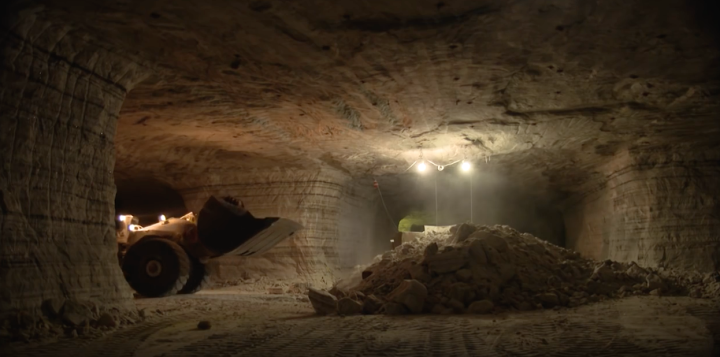
Related Stories
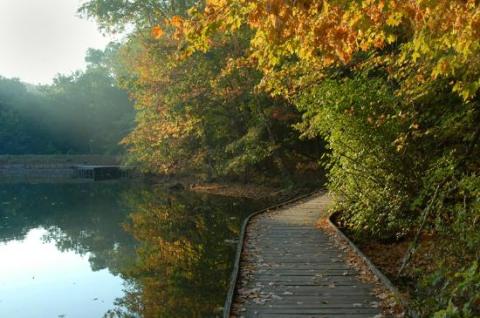
The One Hikeable Lake In Ohio That's Simply Breathtaking In The Fall
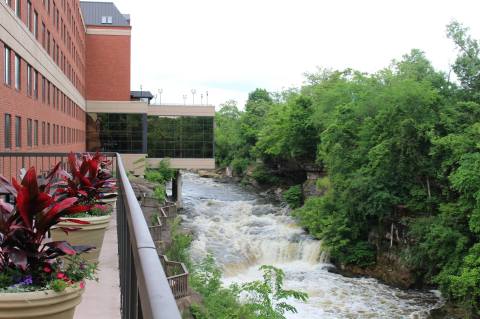
It's Impossible Not To Love This Ohio Restaurant Right On The River

The Beach-Themed Restaurant In Ohio Where It Feels Like Summer All Year Long
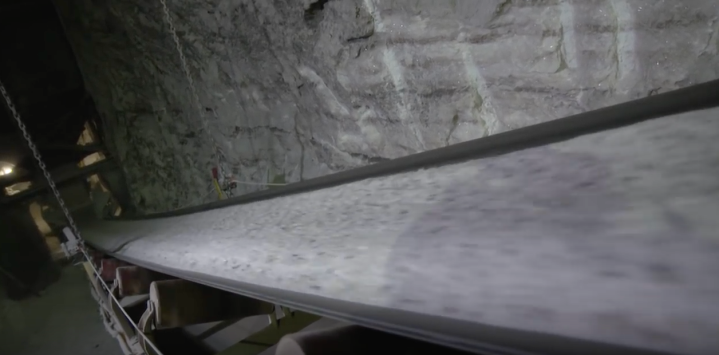
To get a closer look at the salt mine, check out the short video below:
What do you think about this salt mine? Did you know it was hiding in Ohio? Share your thoughts with us!
OnlyInYourState may earn compensation through affiliate links in this article. As an Amazon Associate, we earn from qualifying purchases.
Want more Ohio in your inbox?
Get the latest on things to see, do, and eat around Ohio!
Thank you! You will receive your first email soon.
An error occured.
Related Articles
- The Outdoor Restaurant In Ohio That's So Much More Than A Good Place To Eat
- This Lakeside Cabin Resort In Ohio Is The Ultimate Spot For A Getaway
- The Magical River Walk In Ohio That Will Transport You To Another World
- Dine Among The Trees At This Enchanting Restaurant In Ohio
- This 140-Mile Drive Is The Best Way To See Ohio's Stunning Coast
- The Sinister Story Behind This Popular Ohio Park Will Give You Chills
- The Underrated Ohio Lake That's Perfect For A Summer Day
- 11 Amazing Lake Trips You Need To Take In Ohio This Summer
Explore Ohio
- National & State Parks
- Natural Wonders
- On the Water
- Parks & Gardens
- State Parks
THE 10 BEST Moscow City Tours
City tours in moscow.
- Private Tours
- Walking Tours
- 5.0 of 5 bubbles
- 4.0 of 5 bubbles & up
- 3.0 of 5 bubbles & up
- 2.0 of 5 bubbles & up
- 3rd Transport Ring (TTK)
- District Central (TsAO)
- Garden Ring
- Good for Big Groups
- Good for Couples
- Budget-friendly
- Good for Kids
- Good for a Rainy Day
- Good for Adrenaline Seekers
- Hidden Gems
- Honeymoon spot
- Adventurous
- Things to do ranked using Tripadvisor data including reviews, ratings, photos, and popularity.

1. Moscow Private Tours
2. Moscow through the Eyes of an Engineer
3. Moscow Free Tour
4. Spanish Guide Moscow - Day Tours

5. Bridge to Moscow
6. Go Russia Travel Company

7. Privilege Tour
8. Moscow Navigator
9. Put-in Tours
10. Walks With Folks

11. Moskovskiye Gulyaki

12. Moscow Bike Tours

13. Happy Moscow Tours
14. Tour of Moscow - Day Tours

15. Kremlin Tour
16. MoscowMe
17. IdeaGuide - Your Personal Guide in Moscow
18. Tsar Visit
19. VikiTours

20. Moscow Greeter
21. Excursions in Russia
22. Tour Gratis Moscu

23. Tour-Moscow

24. Gulyayem po Moskve
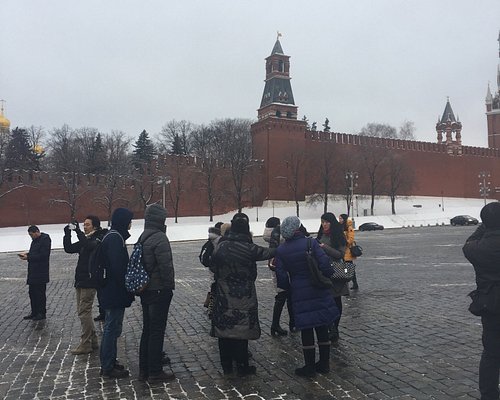
25. Gorodskoi Voyazh
26. Rusiatourmoscu
27. Moscow 360

28. Express to Russia
29. Russia With Love
30. Angel Taxi - Day Tour
What travelers are saying
- Put-in Tours
- Spanish Guide Moscow - Day Tours
- Walks With Folks
- Happy Moscow Tours
- IdeaGuide - Your Personal Guide in Moscow
- Moscow Private Tours
- Tour Gratis Moscu
- Moscow Free Tour
- YourLocalGuide Moscow
- Moscow Bike Tours
- Moscow Navigator
- Moscow through the Eyes of an Engineer
- Angel Taxi - Day Tour
- Your Moscow Guide & Driver
- Excursions in Russia
- Vadim Pavlov Guide and Driver in Moscow
Didn't book FREE tour? Do it now!
2,5 absolutely FREE DAILY walking tour in Moscow. We're TOP-rated company according to TA reviews! Book now and get meeting points details!

TOURS / SERVICES

Testimonial
"A very enjoybale day in Moscow. We had a very nice and knowledgeable guide Anastasia.(Nastia) She was very passionate about the City and we learnt so much in our brief four hours walk with her! Certainly this walking tour added a lot of value to our Moscow Holiday. A great idea to educate visitors about Russia and Moscow. The group was intimate enough to ask questions and stop for snacks etc..we thoriughly enjoyed it and would highly reccomend it.Carry on doing a great job!"
"I really enjoyed the tour, it was a great experience, very informative and fun. I will definitely tell everybody about that tour, keep it it is a fantastic idea!"
"Sorry I do not remember the names :( ... They were very talkative and very into everything. I think they both really love the city, and they made me feel like this to. They knew much about History, which was very informative! Great guides!!!"
"We partook of the fantastic Petersburg Free Tour. Due to our timing during the low season (shockingly not everyone is flocking to Moscow while the average temperature is 15F), it ended up being just us and Sonia, the afore-mentioned super-guide. She quickly ascertained the limited scope of our wanderings.."
2018 Primetime Emmy & James Beard Award Winner
In Transit: Notes from the Underground
Jun 06 2018.
Spend some time in one of Moscow’s finest museums.
Subterranean commuting might not be anyone’s idea of a good time, but even in a city packing the war-games treasures and priceless bejeweled eggs of the Kremlin Armoury and the colossal Soviet pavilions of the VDNKh , the Metro holds up as one of Moscow’s finest museums. Just avoid rush hour.
The Metro is stunning and provides an unrivaled insight into the city’s psyche, past and present, but it also happens to be the best way to get around. Moscow has Uber, and the Russian version called Yandex Taxi , but also some nasty traffic. Metro trains come around every 90 seconds or so, at a more than 99 percent on-time rate. It’s also reasonably priced, with a single ride at 55 cents (and cheaper in bulk). From history to tickets to rules — official and not — here’s what you need to know to get started.
A Brief Introduction Buying Tickets Know Before You Go (Down) Rules An Easy Tour
A Brief Introduction
Moscow’s Metro was a long time coming. Plans for rapid transit to relieve the city’s beleaguered tram system date back to the Imperial era, but a couple of wars and a revolution held up its development. Stalin revived it as part of his grand plan to modernize the Soviet Union in the 1920s and 30s. The first lines and tunnels were constructed with help from engineers from the London Underground, although Stalin’s secret police decided that they had learned too much about Moscow’s layout and had them arrested on espionage charges and deported.
The beauty of its stations (if not its trains) is well-documented, and certainly no accident. In its illustrious first phases and particularly after the Second World War, the greatest architects of Soviet era were recruited to create gleaming temples celebrating the Revolution, the USSR, and the war triumph. No two stations are exactly alike, and each of the classic showpieces has a theme. There are world-famous shrines to Futurist architecture, a celebration of electricity, tributes to individuals and regions of the former Soviet Union. Each marble slab, mosaic tile, or light fixture was placed with intent, all in service to a station’s aesthetic; each element, f rom the smallest brass ear of corn to a large blood-spattered sword on a World War II mural, is an essential part of the whole.

The Metro is a monument to the Soviet propaganda project it was intended to be when it opened in 1935 with the slogan “Building a Palace for the People”. It brought the grand interiors of Imperial Russia to ordinary Muscovites, celebrated the Soviet Union’s past achievements while promising its citizens a bright Soviet future, and of course, it was a show-piece for the world to witness the might and sophistication of life in the Soviet Union.
It may be a museum, but it’s no relic. U p to nine million people use it daily, more than the London Underground and New York Subway combined. (Along with, at one time, about 20 stray dogs that learned to commute on the Metro.)
In its 80+ year history, the Metro has expanded in phases and fits and starts, in step with the fortunes of Moscow and Russia. Now, partly in preparation for the World Cup 2018, it’s also modernizing. New trains allow passengers to walk the entire length of the train without having to change carriages. The system is becoming more visitor-friendly. (There are helpful stickers on the floor marking out the best selfie spots .) But there’s a price to modernity: it’s phasing out one of its beloved institutions, the escalator attendants. Often they are middle-aged or elderly women—“ escalator grandmas ” in news accounts—who have held the post for decades, sitting in their tiny kiosks, scolding commuters for bad escalator etiquette or even bad posture, or telling jokes . They are slated to be replaced, when at all, by members of the escalator maintenance staff.
For all its achievements, the Metro lags behind Moscow’s above-ground growth, as Russia’s capital sprawls ever outwards, generating some of the world’s worst traffic jams . But since 2011, the Metro has been in the middle of an ambitious and long-overdue enlargement; 60 new stations are opening by 2020. If all goes to plan, the 2011-2020 period will have brought 125 miles of new tracks and over 100 new stations — a 40 percent increase — the fastest and largest expansion phase in any period in the Metro’s history.
Facts: 14 lines Opening hours: 5 a.m-1 a.m. Rush hour(s): 8-10 a.m, 4-8 p.m. Single ride: 55₽ (about 85 cents) Wi-Fi network-wide

Buying Tickets
- Ticket machines have a button to switch to English.
- You can buy specific numbers of rides: 1, 2, 5, 11, 20, or 60. Hold up fingers to show how many rides you want to buy.
- There is also a 90-minute ticket , which gets you 1 trip on the metro plus an unlimited number of transfers on other transport (bus, tram, etc) within 90 minutes.
- Or, you can buy day tickets with unlimited rides: one day (218₽/ US$4), three days (415₽/US$7) or seven days (830₽/US$15). Check the rates here to stay up-to-date.
- If you’re going to be using the Metro regularly over a few days, it’s worth getting a Troika card , a contactless, refillable card you can use on all public transport. Using the Metro is cheaper with one of these: a single ride is 36₽, not 55₽. Buy them and refill them in the Metro stations, and they’re valid for 5 years, so you can keep it for next time. Or, if you have a lot of cash left on it when you leave, you can get it refunded at the Metro Service Centers at Ulitsa 1905 Goda, 25 or at Staraya Basmannaya 20, Building 1.
- You can also buy silicone bracelets and keychains with built-in transport chips that you can use as a Troika card. (A Moscow Metro Fitbit!) So far, you can only get these at the Pushkinskaya metro station Live Helpdesk and souvenir shops in the Mayakovskaya and Trubnaya metro stations. The fare is the same as for the Troika card.
- You can also use Apple Pay and Samsung Pay.
Rules, spoken and unspoken
No smoking, no drinking, no filming, no littering. Photography is allowed, although it used to be banned.
Stand to the right on the escalator. Break this rule and you risk the wrath of the legendary escalator attendants. (No shenanigans on the escalators in general.)
Get out of the way. Find an empty corner to hide in when you get off a train and need to stare at your phone. Watch out getting out of the train in general; when your train doors open, people tend to appear from nowhere or from behind ornate marble columns, walking full-speed.
Always offer your seat to elderly ladies (what are you, a monster?).
An Easy Tour
This is no Metro Marathon ( 199 stations in 20 hours ). It’s an easy tour, taking in most—though not all—of the notable stations, the bulk of it going clockwise along the Circle line, with a couple of short detours. These stations are within minutes of one another, and the whole tour should take about 1-2 hours.
Start at Mayakovskaya Metro station , at the corner of Tverskaya and Garden Ring, Triumfalnaya Square, Moskva, Russia, 125047.
1. Mayakovskaya. Named for Russian Futurist Movement poet Vladimir Mayakovsky and an attempt to bring to life the future he imagined in his poems. (The Futurist Movement, natch, was all about a rejecting the past and celebrating all things speed, industry, modern machines, youth, modernity.) The result: an Art Deco masterpiece that won the National Grand Prix for architecture at the New York World’s Fair in 1939. It’s all smooth, rounded shine and light, and gentle arches supported by columns of dark pink marble and stainless aircraft steel. Each of its 34 ceiling niches has a mosaic. During World War II, the station was used as an air-raid shelter and, at one point, a bunker for Stalin. He gave a subdued but rousing speech here in Nov. 6, 1941 as the Nazis bombed the city above.

Take the 3/Green line one station to:
2. Belorusskaya. Opened in 1952, named after the connected Belarussky Rail Terminal, which runs trains between Moscow and Belarus. This is a light marble affair with a white, cake-like ceiling, lined with Belorussian patterns and 12 Florentine ceiling mosaics depicting life in Belarussia when it was built.

Transfer onto the 1/Brown line. Then, one stop (clockwise) t o:
3. Novoslobodskaya. This station was designed around the stained-glass panels, which were made in Latvia, because Alexey Dushkin, the Soviet starchitect who dreamed it up (and also designed Mayakovskaya station) couldn’t find the glass and craft locally. The stained glass is the same used for Riga’s Cathedral, and the panels feature plants, flowers, members of the Soviet intelligentsia (musician, artist, architect) and geometric shapes.

Go two stops east on the 1/Circle line to:
4. Komsomolskaya. Named after the Komsomol, or the Young Communist League, this might just be peak Stalin Metro style. Underneath the hub for three regional railways, it was intended to be a grand gateway to Moscow and is today its busiest station. It has chandeliers; a yellow ceiling with Baroque embellishments; and in the main hall, a colossal red star overlaid on golden, shimmering tiles. Designer Alexey Shchusev designed it as an homage to the speech Stalin gave at Red Square on Nov. 7, 1941, in which he invoked Russia’s illustrious military leaders as a pep talk to Soviet soldiers through the first catastrophic year of the war. The station’s eight large mosaics are of the leaders referenced in the speech, such as Alexander Nevsky, a 13th-century prince and military commander who bested German and Swedish invading armies.

One more stop clockwise to Kurskaya station, and change onto the 3/Blue line, and go one stop to:
5. Baumanskaya. Opened in 1944. Named for the Bolshevik Revolutionary Nikolai Bauman , whose monument and namesake district are aboveground here. Though he seemed like a nasty piece of work (he apparently once publicly mocked a woman he had impregnated, who later hung herself), he became a Revolutionary martyr when he was killed in 1905 in a skirmish with a monarchist, who hit him on the head with part of a steel pipe. The station is in Art Deco style with atmospherically dim lighting, and a series of bronze sculptures of soldiers and homefront heroes during the War. At one end, there is a large mosaic portrait of Lenin.

Stay on that train direction one more east to:
6. Elektrozavodskaya. As you may have guessed from the name, this station is the Metro’s tribute to all thing electrical, built in 1944 and named after a nearby lightbulb factory. It has marble bas-relief sculptures of important figures in electrical engineering, and others illustrating the Soviet Union’s war-time struggles at home. The ceiling’s recurring rows of circular lamps give the station’s main tunnel a comforting glow, and a pleasing visual effect.

Double back two stops to Kurskaya station , and change back to the 1/Circle line. Sit tight for six stations to:
7. Kiyevskaya. This was the last station on the Circle line to be built, in 1954, completed under Nikita Khrushchev’ s guidance, as a tribute to his homeland, Ukraine. Its three large station halls feature images celebrating Ukraine’s contributions to the Soviet Union and Russo-Ukrainian unity, depicting musicians, textile-working, soldiers, farmers. (One hall has frescoes, one mosaics, and the third murals.) Shortly after it was completed, Khrushchev condemned the architectural excesses and unnecessary luxury of the Stalin era, which ushered in an epoch of more austere Metro stations. According to the legend at least, he timed the policy in part to ensure no Metro station built after could outshine Kiyevskaya.

Change to the 3/Blue line and go one stop west.
8. Park Pobedy. This is the deepest station on the Metro, with one of the world’s longest escalators, at 413 feet. If you stand still, the escalator ride to the surface takes about three minutes .) Opened in 2003 at Victory Park, the station celebrates two of Russia’s great military victories. Each end has a mural by Georgian artist Zurab Tsereteli, who also designed the “ Good Defeats Evil ” statue at the UN headquarters in New York. One mural depicts the Russian generals’ victory over the French in 1812 and the other, the German surrender of 1945. The latter is particularly striking; equal parts dramatic, triumphant, and gruesome. To the side, Red Army soldiers trample Nazi flags, and if you look closely there’s some blood spatter among the detail. Still, the biggest impressions here are the marble shine of the chessboard floor pattern and the pleasingly geometric effect if you view from one end to the other.

Keep going one more stop west to:
9. Slavyansky Bulvar. One of the Metro’s youngest stations, it opened in 2008. With far higher ceilings than many other stations—which tend to have covered central tunnels on the platforms—it has an “open-air” feel (or as close to it as you can get, one hundred feet under). It’s an homage to French architect Hector Guimard, he of the Art Nouveau entrances for the Paris M é tro, and that’s precisely what this looks like: A Moscow homage to the Paris M é tro, with an additional forest theme. A Cyrillic twist on Guimard’s Metro-style lettering over the benches, furnished with t rees and branch motifs, including creeping vines as towering lamp-posts.

Stay on the 3/Blue line and double back four stations to:
10. Arbatskaya. Its first iteration, Arbatskaya-Smolenskaya station, was damaged by German bombs in 1941. It was rebuilt in 1953, and designed to double as a bomb shelter in the event of nuclear war, although unusually for stations built in the post-war phase, this one doesn’t have a war theme. It may also be one of the system’s most elegant: Baroque, but toned down a little, with red marble floors and white ceilings with gilded bronze c handeliers.

Jump back on the 3/Blue line in the same direction and take it one more stop:
11. Ploshchad Revolyutsii (Revolution Square). Opened in 1938, and serving Red Square and the Kremlin . Its renowned central hall has marble columns flanked by 76 bronze statues of Soviet heroes: soldiers, students, farmers, athletes, writers, parents. Some of these statues’ appendages have a yellow sheen from decades of Moscow’s commuters rubbing them for good luck. Among the most popular for a superstitious walk-by rub: the snout of a frontier guard’s dog, a soldier’s gun (where the touch of millions of human hands have tapered the gun barrel into a fine, pointy blade), a baby’s foot, and a woman’s knee. (A brass rooster also sports the telltale gold sheen, though I am told that rubbing the rooster is thought to bring bad luck. )
Now take the escalator up, and get some fresh air.

R&K Insider
Join our newsletter to get exclusives on where our correspondents travel, what they eat, where they stay. Free to sign up.
21 Things to Know Before You Go to Moscow
Featured city guides.
- Guided tour
Moscow: City Sightseeing by Car/Bus
- Description
- Choose date

Visiting a new city is akin to going on a first date, it is something you will never forget. Many people imagine Moscow as just a bunch of sporadic landmarks: Red Square, the Kremlin, Lenin’s Mausoleum and GUM. There is so much more to this wonderful city than that and even though we only have a few hours, we will do all we can to show you everything we know and love about our capital in one fell swoop. We will take you on a journey through the ages, from centuries ago, right up to the modern day, soaking in the sights of this vast and bustling metropolis. Bright, luxurious and both ancient and modern at the same time, Moscow invites you on a date you’ll never forget!
On our sightseeing bus tour of the city, you will see:
- The wonderfully historic city centre and its unique museums, magnificent cathedrals, the exquisite Chambers of the Romanov Boyars and of course, the famous towering red brick walls of the Kremlin, The charming beauty of the Alexander Garden awaits the capital's guests - a lush green oasis in the midst of the glass and concrete clad metropolis, basking in the etherial aura emanating from the whitewashed stone walls of the restored Cathedral of Christ the Saviour, the world- renowned fairytale onion domes of St. Basil's Cathedral and other impressive monumental buildings such as the library built in Lenin's honour - the Russian State Library - and the State Duma.
- The Lubyanka KGB headquarters is notorious to members of older generations and although nowadays, the face of the secret police has changed dramatically, the looming enigmatic building on the waterfront maintains its aura of mystery, shrouded in a variety of murky rumours and dark myths. Then, there’s another of Moscow's main attractions - the marvellous Bolshoi Theatre, yew simply cant leave Moscow without taking in its breathtaking architecture. Engrained in the fabric of Russia's cultural heritage, virtuoso performers such as prima ballerina Galina Ulanova, opera singer Feodor Chaliapin and pianist, composer and conductor Sergei Rachmaninoff once stood centre stage of this vaunted institution.
- The memorial complex on Poklonnaya Hill was constructed in the glory and honour of our heroes who defended our nation in the many crucial battles of the Great Patriotic War (WWII). This is a place that embodies a particularly acute and inextricable link between older ancf younger generations. Moving on to the Moscow International Business Centre, not dubbed ‘Moscow City' for nothing, a true glimpse of the future in the present. This incredible, rather jaw-dropping project in the capital has shown that Moscow has come to accept the age of the skyscraper. Finally, the stunning views from the observation deck at Sparrow Hills will leave professional and amateur photographers alike itching to capture them. How could one resist?
The most beautiful of all the world's cities - lady Moscow invites you out on a date!
The cost of an excursion with a personal guide for 1 person
Meeting point We'll pick you up at your hotel
St. Basil's Cathedral
House on the Embankment
Cathedral of Christ the Saviour
Vorobyovy Hills
Poklonnaya Hill Poklonnaya Gora
Moscow-City
Alexander garden
Russian State Library
Bolshoi Theatre
End of the tour
Choose your dates
Select time, who's going.
- Excursion Moscow: City Sightseeing by Car/Bus
- Date and time:
- Who's going:

COMMENTS
The mines, located underneath Lake Erie, harvest about 12,000 tons of salt every day. By Jacob DeSmit. On Whiskey Island, a large, cage-like hoist travels 1,800 feet beneath Lake Erie at a four-minute pace — a rapid trip that feels like a hellish eternity to an outsider. For Cargill employees, the descent, which can reach a top speed of 500 ...
An Unexpected Salt Mine Is Hiding Underground In This Lake In Ohio. Most people have no idea there's a whole other world lurking beneath Whiskey Island in northeast Ohio. About 1,800 ft. below Lake Erie just offshore of Cleveland is Cargill's Salt Mine—and it truly looks like another planet.
My understanding is that public tours of both the Cargill salt mine in Cleveland and the Morton salt mine in Grand River are both ... pucgal. Miami. Level Contributor . 784 posts. 2. Re: Salt Mine Tours . 8 years ago. Save. I suspected as much. Thank you for the confirmation. Report inappropriate content . 3. Re: Salt Mine Tours . 7 years ago ...
CLEVELAND, Ohio -- Deep beneath Lake Erie is a massive salt mine, stretching from Edgewater Beach to Burke Lakefront Airport and north about 3 miles. Cargill Deicing Technology extracts as much as ...
About 2,000 feet (609 metres) under Lake Erie, 30 miles (48 km) east of Cleveland in Fairport Harbour, Ohio, you'll find a vast site called the Morton Salt Mine. Since 1959, the Fairport Harbour Morton Salt Mine has been exclusively mining for rock salt, which is most commonly used to melt snow and ice on roads.
See the other world of the Cargill salt mine, nearly 1,700 feet below Lake Erie. For the full mine tour video, visit Rockthelake.com
With just over 40 employees, Cargill has a major role in protecting the environment. "We are a big part of the island," said Cargill production manager Daniel DeAnda Jr., adding that the land Cargill leases for salt production accounts for about 13 percent of the 115-square-mile island and the bulk of the narrow, sea-level southern end.
Go 1,800 feet below Lake Erie into a network of mining tunnels that spans nearly 3 miles away from the Cleveland shoreline. Cargill mines nearly 4 million to...
Our most popular tour! A full 2 hour tour into the Salt Mines of Hutchinson. Includes your underground admission, Dark Ride, and Train Ride. RATES. Adults $25. Ages 13-59 Children $18. Ages 4-12 Seniors 60+ & Military $23 *Limit 1 per ID number Reno County Residents ...
Todd Meany goes underground to the salt mines
The Salt Safari is a specialized tour that is a 1-hour tour that goes out into the 1950 section of the mine. What are the yellow hard hats for? The yellow hat that some guests receive indicate that they are going on the Salt Safari.
In 1915, John Clute organized the Rock Salt Corporation on Portland Point in Lansing. In 1916, the shaft was sunk to -1,500 feet, but the salt was of poor quality. By 1918 the mine was still not producing well and was shut down. In 1921, Frank L. Bolton and John W. Shannon bought the mine and further sank the shaft to -2,000 feet to a better ...
Cargill Deicing Technology operates one of its three mines in Lansing, NY, providing customers with deicing technology and road salt that saves lives, enhances commerce and reduces environmental impact. Cargill acquired the mine in 1970 and annually produces approximately 2 million tons of road salt that is shipped to more than 1,500 locations ...
One of three Cargill mines in the U.S. that produce rock salt used to deice winter roads, Avery produces about 2 million tons of salt a year — roughly the same amount as its Lansing mine beneath Cayuga Lake. The other Cargill salt mine under Lake Erie near Cleveland produces about 3 million tons a year. The Avery mine employs about 200 people.
The mine is filled with unique experiences and decades of history that you can only get 650 feet below this small Kansas town. Everyone who walks through our doors becomes a part of our underground community. Make memories underground that you and your family will hold close and cherish forever. Join the adventure, book your tour today!
A typical coal mine is 100 to 200 feet below ground, he said, while the Cargill salt mine is 1,700 feet below the bottom of the lake, which means it's highly unlikely a breach of the mine would ...
(Water Front, 10-25-23, by Peter Mantius) LANSING, Oct. 25, 2023 — State and local lawmakers joined clean water advocates today in a virtual press conference to urge Gov. Kathy Hochul to protect Cayuga Lake by blocking any sudden "secret" sale of Cargill Inc.'s giant salt mine in Lansing. "Cargill can't skip town and leave Finger…
LANSING, N.Y. — Cargill, Inc. submitted an application to the New York Department of Environmental Conservation (DEC) in June 2023 to modify its mining permit for its salt mine 2,000 feet under Cayuga Lake. The company wants to establish additional water storage areas to store groundwater leaking into the mine.
About 1,800 ft. below Lake Erie just offshore of Cleveland is Cargill's Salt Mine—and it truly looks like another planet. If you've ever wondered where all the rock salt that covers Ohio's streets in the wintertime comes from, this incredible mine is the answer. ... Although tours are no longer offered of the mine, just knowing it's ...
5. Bridge to Moscow. 454. City Tours • Cultural Tours. Basmanny. By Charito1967. Our tour guide was the best, very knowledgeable and lots of patience and caring to explain and to help us in all we r... 6. Go Russia Travel Company.
Moscow Free Tour Meeting Point DETAILED DIRECTIONS FOR YOUR COMFORT: 1. Go to Kitay Gorod metro station (Purple Line (#7) or Orange Line (#6)). 2. Take the escalator up (not the stairs!) 3. Find the monument to Cyril and Methodius in the center of Slavyanskaya Square ( see how it looks).Our guide will wait for you in front of this monument with a big red umbrella saying "Moscow Free tour" 4.
An Easy Tour. A Brief Introduction. Moscow's Metro was a long time coming. Plans for rapid transit to relieve the city's beleaguered tram system date back to the Imperial era, but a couple of wars and a revolution held up its development. Stalin revived it as part of his grand plan to modernize the Soviet Union in the 1920s and 30s.
On our sightseeing bus tour of the city, you will see: The wonderfully historic city centre and its unique museums, magnificent cathedrals, the exquisite Chambers of the Romanov Boyars and of course, the famous towering red brick walls of the Kremlin, The charming beauty of the Alexander Garden awaits the capital's guests - a lush green oasis in the midst of the glass and concrete clad ...